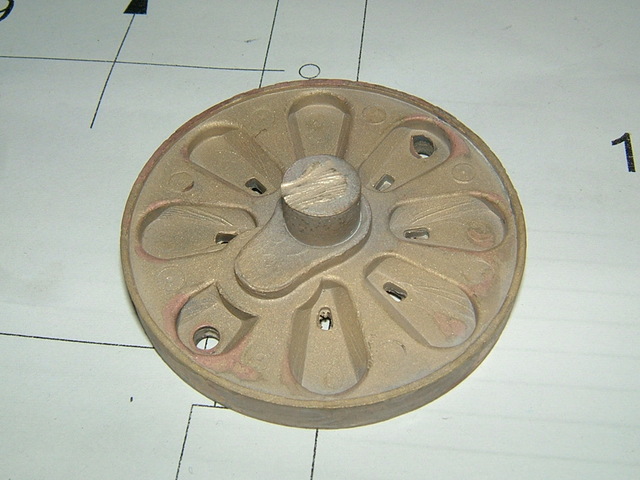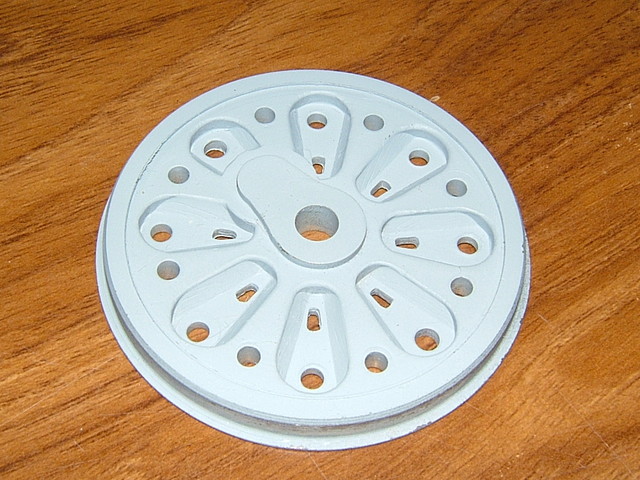The water pump pulley was turned and trial assembled on the engine to verify its alignment with the crankshaft pulley. A 1/10" thick o-ring will eventually be used for the belt, but the fit was checked with an on-hand -038 o-ring. The pulley will be painted later along with the fan and spacer block after they're fabricated.
Coolant will eventually flow from the engine to the radiator's upper tank through a thermostat housing attached to the front of the block. Although there's really no thermostat, the housing was a significant machining project. I was able to come up with a bulbous design reminiscent of the full-size casting that I was machinable through only two workpiece faces. It was completed in three setups similar to those used for the water pump.
Construction began by squaring up a small block of aluminum. A single corner was used as the machining reference for all three setups in order to minimize registration errors. The bottom face of the housing was machined first and included a groove for an o-ring seal to the block. Holes for the housing's mounting screws were drilled and temporarily tapped for use later with a fixture plate. All of the housing's features that were accessible through the bottom face of the workpiece were then machined.
The workpiece was then flipped over and attached to a fixture plate where the rest of the machining was completed through the top face of the workpiece. The nozzle was drilled through and reamed in the third setup. Before painting the housing, a steel ferrule that added a hose sealing barb was turned and pressed into the end of the nozzle. A similar ferrule was added to the water pump's inlet nozzle.
The water pump and thermostat housing were bead blasted and air-brushed with blue Gun Kote to match the block. I'm finally getting the hang of air brushing. The trick to painting these small model parts seems to be to keep a high air-to-paint flow to minimize the paint particle size. Spraying many barely perceptible light coats on a glass-beaded metal surface allows the sheen to be fine tuned between satin and gloss. This technique seems to work well with Gun Kote which remains tacky until its heat cure. I'm not sure however it would work with more conventional solvent-based paints. - Terry










Coolant will eventually flow from the engine to the radiator's upper tank through a thermostat housing attached to the front of the block. Although there's really no thermostat, the housing was a significant machining project. I was able to come up with a bulbous design reminiscent of the full-size casting that I was machinable through only two workpiece faces. It was completed in three setups similar to those used for the water pump.
Construction began by squaring up a small block of aluminum. A single corner was used as the machining reference for all three setups in order to minimize registration errors. The bottom face of the housing was machined first and included a groove for an o-ring seal to the block. Holes for the housing's mounting screws were drilled and temporarily tapped for use later with a fixture plate. All of the housing's features that were accessible through the bottom face of the workpiece were then machined.
The workpiece was then flipped over and attached to a fixture plate where the rest of the machining was completed through the top face of the workpiece. The nozzle was drilled through and reamed in the third setup. Before painting the housing, a steel ferrule that added a hose sealing barb was turned and pressed into the end of the nozzle. A similar ferrule was added to the water pump's inlet nozzle.
The water pump and thermostat housing were bead blasted and air-brushed with blue Gun Kote to match the block. I'm finally getting the hang of air brushing. The trick to painting these small model parts seems to be to keep a high air-to-paint flow to minimize the paint particle size. Spraying many barely perceptible light coats on a glass-beaded metal surface allows the sheen to be fine tuned between satin and gloss. This technique seems to work well with Gun Kote which remains tacky until its heat cure. I'm not sure however it would work with more conventional solvent-based paints. - Terry

































![MeshMagic 3D Free 3D Modeling Software [Download]](https://m.media-amazon.com/images/I/B1U+p8ewjGS._SL500_.png)

![DreamPlan Home Design and Landscaping Software Free for Windows [PC Download]](https://m.media-amazon.com/images/I/51kvZH2dVLL._SL500_.jpg)




































